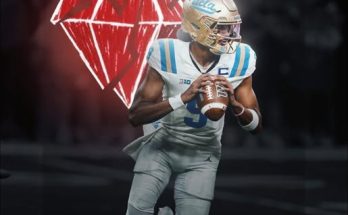According to Pro Football Network, the Arizona Cardinals face considerable uncertainty at the wide receiver position
As the Arizona Cardinals prepare for the upcoming NFL season, optimism is in the air. The return of quarterback Kyler Murray to full health, the development of a young defense, and a clearer identity under head coach Jonathan Gannon are all reasons for fans to believe the franchise is turning a corner. Yet, one critical area remains a significant concern: the wide receiver room. According to Pro Football Network, the Cardinals face considerable uncertainty at the wide receiver position—a reality that could shape their offensive ceiling in 2025.
Wide receiver has traditionally been a cornerstone of Arizona’s offense. From the Larry Fitzgerald era to the more recent stints of DeAndre Hopkins, the position has often been a source of stability and star power. But the post-Hopkins period has brought transition, inconsistency, and an ongoing search for answers. With the 2025 season looming, the Cardinals must find clarity quickly in order to complement Murray’s skill set and provide a balanced, dynamic passing attack.
The bright spot, of course, is Marvin Harrison Jr., the fourth overall pick in the 2024 NFL Draft. Drafted to be a game-changing playmaker, Harrison comes in with immense expectations. His college career at Ohio State was nothing short of spectacular. With elite route-running, exceptional ball skills, and the pedigree of an NFL legend, Harrison was widely considered the best receiver prospect in years. He has all the tools to become a WR1 from day one.
However, relying on a rookie—even one as talented as Harrison—always carries risk. The jump from college to the NFL is steep. Adjusting to professional speed, complex coverages, and elite defensive backs can take time. While Harrison is poised and mature beyond his years, he will still be navigating the steepest learning curve of his football life. Putting the burden of revitalizing the entire receiving corps on his shoulders is both unfair and potentially damaging to his development.
Beyond Harrison, the room gets murkier. Michael Wilson, a 2023 third-round pick, showed flashes of potential during his rookie campaign. At 6’2″, he offers size, toughness, and a willingness to work the middle of the field. He has strong hands and runs precise routes. But questions remain about his durability—an issue that followed him throughout college—and whether he can consistently win against top-tier NFL corners. While he projects as a solid WR2 or WR3, Wilson has yet to prove that he can be a reliable week-to-week contributor at the professional level.
Another name in the mix is Greg Dortch, a fan favorite known for his heart, speed, and shiftiness. Despite being undersized, Dortch has earned his spot through sheer determination and timely plays. He is especially dangerous in open space and could carve out a role as a slot specialist or gadget player. However, he lacks the physicality and outside presence needed to fill larger roles in the offense, which limits how much Arizona can depend on him for volume production.
Then there’s Rondale Moore, the 2021 second-round pick whose NFL career has been a roller coaster. Moore entered the league with significant hype, boasting blazing speed and playmaking ability. The Cardinals envisioned him as a do-it-all weapon—lining up in the slot, on screens, in the backfield, and even on special teams. But injuries and inconsistency have derailed his development. While Moore has moments where his talent shines through, he has yet to establish himself as a consistent, reliable piece of the offense. This season may very well be a make-or-break year for him in Arizona.
The rest of the depth chart is filled with players fighting for roster spots—undrafted free agents, practice squad graduates, and journeymen hoping to catch on. While one or two of these players could emerge during camp or preseason, it’s unlikely that any of them will significantly alter the landscape of the receiver group. Without meaningful contributions from this tier, the top four or five players will carry nearly all of the load—raising injury concerns and questions about depth.
This uncertainty has not gone unnoticed by Pro Football Network and other analysts. In today’s NFL, having a deep and versatile receiving corps is nearly essential for sustained offensive success. With passing games becoming more sophisticated and defenses faster and more aggressive, offenses must spread the field with multiple capable receivers. One elite target, no matter how talented, is not enough. Defenses will adjust. Double teams will come. Success in the passing game now relies on having multiple threats who can win in various ways—deep, underneath, over the middle, and on the perimeter.
Adding to the pressure is the fact that Kyler Murray’s playing style depends on trust in his receivers. He thrives when he can read the field quickly and deliver the ball with confidence, especially on timing routes. When the receiving corps lacks cohesion or experience, it can lead to hesitation, broken plays, or forced throws. For Murray to return to Pro Bowl form, he needs chemistry and continuity with his wideouts—something the current group has yet to establish.
The Cardinals also face a scheduling gauntlet that includes strong secondaries from teams like the San Francisco 49ers, Baltimore Ravens, and Dallas Cowboys. These matchups will challenge Arizona’s receivers to separate quickly, make contested catches, and maintain discipline in route-running. The lack of veteran presence in the wide receiver room could become a glaring issue when facing seasoned defensive backs capable of capitalizing on mistakes.
It’s worth noting that Arizona still has options. The team could explore the trade market for a veteran receiver. Several players around the league may become available as teams trim rosters or recalibrate heading into the season. A mid-tier veteran—someone with playoff experience or a history of steady production—could provide both a safety net for Murray and a mentor for the younger players. Alternatively, the Cardinals could monitor free agents still on the market and invite competition into the locker room.
Another strategy could be increasing the use of tight ends in the passing game. Trey McBride emerged last season as a serious offensive weapon. His ability to line up in multiple positions and stretch the field down the seam gives Arizona flexibility in how they deploy personnel. Pairing McBride with Harrison and Wilson could create matchup problems for defenses, especially in two-tight end sets that protect against pressure and support the run game. While this doesn’t solve the depth issue at wide receiver, it could help mitigate it.
Ultimately, the Cardinals’ success this season will hinge on how quickly the wide receiver group can gel and perform. If Harrison delivers as expected, Wilson stays healthy, and Moore takes the next step, Arizona’s offense could surprise people. But if injuries strike or development stalls, the unit could become a liability—and one that opponents will be quick to exploit.
The front office and coaching staff must also navigate the delicate balance of developing young talent while trying to win games now. Investing in Harrison’s growth is vital, but the team can’t afford to lean too heavily on a rookie to solve all their problems. Offensive coordinator Drew Petzing will need to get creative—using motion, play-action, and formations to help receivers get open and keep defenses honest.
There’s no denying the potential in the wide receiver room. The talent is there, and the upside is real. But potential doesn’t win games—production does. The Cardinals must turn promise into performance, and they need to do it quickly. In a league that offers little patience for growing pains, especially at the skill positions, the spotlight will shine brightly on Arizona’s pass catchers.
According to Pro Football Network’s evaluation, the Cardinals are firmly in the “prove it” stage at wide receiver. While the addition of a blue-chip rookie like Harrison is encouraging, the overall uncertainty at the position remains a critical issue heading into the season. Whether this group rises to the occasion or falters under pressure could very well determine the Cardinals’ fate in 2025.
One thing is certain: the Arizona Cardinals are a team in transition—rebuilding with intention, coaching with urgency, and planning for a brighter future. If the wide receiver unit can match the energy and ambition of the rest of the roster, that future could arrive sooner than expected. But for now, the uncertainty remains. And only time will tell whether it becomes the story of the season—or the challenge they overcame on the road to relevance.



